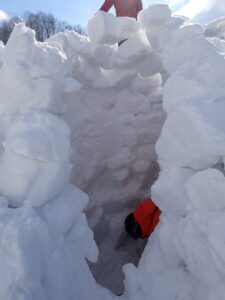切り抜き詳細
- 発行日時
- 2024-3-21 13:00
- 見出し
- 緊急時のイグルー・ビバークの可能性
- 記事詳細
-
先週の雪崩事故、救助までの一晩
先週の2024年3月14日に長野県・白馬連峰の小日向山北東斜面で発生した雪崩事故について、関係者からの聞き取りを行って書いたという日本雪崩ネットワークのweb記事で、雪崩事故のあと、骨折で動けないメンバーと救助を待つ一晩、イグルーを作りかけたとの記事がありました。「P2は痛みにより、まったく動けなかったため、周辺の木、スキー、雪を使い、イグルーを作成。その後、雪洞に移動し、お湯を沸かし、夜を明かす。」とありました。当日は連絡はついたものの、ヘリ救助には厳しい天候のため、翌朝のフライトまで一晩過ごしたとのことです。骨折した負傷者は寒いでしょうから、長時間安静にできる場が絶対に必要なんです。手持ちの道具と材料で、その場でできることをやってみる、そのためのヒントになることは頭に入れておく。これが山登りで最も大切な点で、奥深い魅力でもあると思います。これだけの文面から、以下は私の想像です

ノコが無かったりしてスコップだけで作ると、積んでも不安定で、真上にしか乗らず壁ができるだけです。ノコで安定のブロックを作るから屋根ができるのですIf you don’t have a saw and only use a shovel to construct, it’s unstable when piled up, only stacking directly above and forming walls. It’s the stability of the blocks made with a saw that allows for the roof to be formed.
おそらくノコギリが無かったので屋根を塞げるきちっとしたブロックまでは切り出せず、雪の壁の上にスキーや木の枝をかぶせてブロックを載せようと試みたのではないかな。隙間風などで寒く、あまり快適ではなかったので、周辺で雪洞を作れる十分な積雪と時間が十分あり、作った経験のある雪洞に結果的に切り替えたのでしょう。
というのも、ノコギリさえあれば隙間風なく屋根のあるイグルーは何とか作れただろうし、イグルー経験があればノコギリは持っていただろうと思うからです。でも、イグルーを作ってみよう!と思い至った経過は、とてもうれしいです。ノコギリはたいして重くないし、焚火も各段にやりやすいし、負傷者の寝床にノコで集めた針葉樹の葉の茂った小枝を敷き詰めれば快適なベッドもできます。日帰りならマットもなくて尻が冷たかったと思います。写真ではこの現場には針葉樹は無かったようですが。日帰りの山スキー山行でノコなんか持って行かないよ、という人は、今は多数派でしょう。でも、ビーコンもプローブもなかった頃から北大の山岳部ではスコップとともに持っていきました。4000〜5000円で買えるし、一生ものです。ぜひ一本どうぞ。夏も活躍します。“The possibility of using an igloo for emergency bivouacking.”
The night until rescue following last week’s avalanche accident
In a web article by the Japan Avalanche Network, based on interviews with involved parties, it was reported that following last week’s avalanche incident on March 14, 2024, on the northeast slope of Mt. Kohinata in the Hakuba Range, Nagano Prefecture, one member, unable to move due to a fracture, spent the night awaiting rescue, attempting to construct an igloo.
“Using nearby trees, skis, and snow, P2 created the structure but later moved into a snow cave, where they boiled water to spend the night.”
Although contact was established that day, harsh weather conditions prevented helicopter rescue until the following morning. It was essential to provide a place for the injured with a fracture to remain immobile for an extended period, considering the cold. The importance of being prepared to improvise with available tools and materials in such situations cannot be overstated. This epitomizes the essence and profound allure of mountaineering.
Based on this text alone, the following is my speculation
From this account, it seems likely that due to the absence of a saw, they couldn’t create tightly fitting blocks for the roof, so they attempted to cover blocks placed atop the snow wall with skis or tree branches. However, due to drafts and discomfort, they ultimately switched to a snow cave, benefiting from ample snow and time. If they had a saw, they might have managed to construct a more comfortable igloo with a draft-free roof. However, the decision to attempt building an igloo was still commendable.
A saw is not particularly heavy, and it greatly facilitates tasks like making a fire. Additionally, laying pine boughs collected with a saw as a bed for the injured person would provide comfort. Those on day trips for skiing or mountaineering might not typically carry a saw, but in Hokkaido University’s mountain club, we have always carried one alongside a shovel, even before the days of beacons and probes. They are affordable at around ?4000-?5000 and are a lifelong investment. I highly recommend having one, as they are useful not only in winter but also during summer outings.”
今回から英訳をつけました。
 HOME
HOME
 メニュー
メニュー
